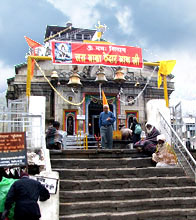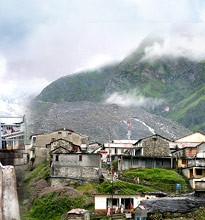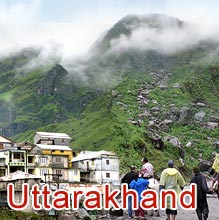 Rangoli, a traditional Indian art displayed in front of the house, makes up a sacred and age-old practice. Aipan is one of the conventional forms of rangoli, mainly practiced in the state of Uttarakhand. The art has cultural as well as religious implication in the life of the Kumanois. In Uttarakhand, Aipan designs are mainly drawn at places of worship, along with the main entry door and the front courtyard of the house. The beauty created by the art is very much appealing to the eyes and steals the heart, of not just the creator, but also the beholder. The word 'Aipan' is a derivative of 'Arpan'. A commonly used word for the art is “Likhai” (writing), although it is a pattern made with the fingers.
Rangoli, a traditional Indian art displayed in front of the house, makes up a sacred and age-old practice. Aipan is one of the conventional forms of rangoli, mainly practiced in the state of Uttarakhand. The art has cultural as well as religious implication in the life of the Kumanois. In Uttarakhand, Aipan designs are mainly drawn at places of worship, along with the main entry door and the front courtyard of the house. The beauty created by the art is very much appealing to the eyes and steals the heart, of not just the creator, but also the beholder. The word 'Aipan' is a derivative of 'Arpan'. A commonly used word for the art is “Likhai” (writing), although it is a pattern made with the fingers. Aipan is used as a ritual design for pujas, festivals and ceremonies connected with birth, janeu (the sacred thread ceremony), marriage and death. The raw material used for making it is simple ochre (Geru) colour and rice paste. Aipan is drawn using the last three fingers of the right hand. In a family, it is the womenfolk who make these beautiful designs. They pass on the designs and patterns to their daughters and daughters-in-law, to preserve the culture. There are different designs of 'Aipan', each having a special implication and drawn with a specific purpose in mind. We have given the different forms of Aipan designs and patterns, in the lines below.
Different Forms of Aipans
Saraswati Chowki: The main feature of Saraswati chowki is a five-pointed star, with a swastik flower or a diya in the center. The artist decorates the center piece with flowing designs or floral patterns. This aipan is made when a child begins formal education. During this time, a puja is also held to give him/her an auspicious start. The form of aipan has been named after goddess 'Saraswati', the Goddess of Learning.
Chamunda Hast Chowki: Chamunda Hast Chowki comprises of a circles, within which there are two triangles, interspersed with two diagonal lines that runs across both of them. There is a 5-pointed star in between, making it centerpiece of this chowki. The gaps in the pattern are filled with floral designs or Lakshmi's feet. The circle itself is often decorated with 8 petals of the lotus. This type of aipan is made during "havans" or "yagnas".
Nav Durga Chowki: The main points of Nav Durga Chowki are nine dots, representing the Nav Durgas. The dots are enclosed within a square, with parallel lines running in a crisscross fashion, decorated with lotus petals. A simpler way is to form swastiks with the nine dots; which is called Nav Swastik. There are many variations of this chowki. A simpler version is made by drawing three horizontal and vertical lines, with a Swastik in the centre. This type of aipan is made at the time of Devi puja.
Shiv or Shivarchan Peeth: Shivarchan Peeth comprises of an eight-cornered design, with 12 dots joined by 12 lines. To make it more attractive, there is an outside border, drawn with four corners. This type of aipan is made in the month of Savan or Magh, which is specifically dedicated to Lord Shiva. In this month, 28 or 108 Parthiv Lings are placed in a copper thali and Shivarchan Peeth is drawn on the ground.
Surya Darshan Chowki: Surya Darshan chowki is made for the naming ceremony of a newborn child. It is drawn on the floor, where the priest sits reciting the mantras. For ten days after his birth, the baby is kept indoors. He is brought out on the eleventh day, for Surya Darshan. This is followed by the naming ceremony.
Janeyu Chowki: Janeyu Chowki comprises of seven stars, made within a six-sided drawing. The seven stars in the aipan represent the Sapt Rishis. Around the six-sided drawing, a number of dots are drawn. This chowki is made especially for the sanctified thread ceremony, called janeyu.
 Asan Chowki: Asan Chowki is made to decorate the seats of a devotee and his wife, for a ritual puja. This is associated with the many kinds of chowkis used for various pujas.
Asan Chowki: Asan Chowki is made to decorate the seats of a devotee and his wife, for a ritual puja. This is associated with the many kinds of chowkis used for various pujas.Acharya Chowki: In Acharya Chowki, a Swastik is made on the floor, with red color. Lotus and other auspicious symbols, such as bell, conch shell, and two parrots, are painted around the Swastik. This type of aipan is made during marriages, where the groom is always accompanied by his own Pandit or Acharya. It is drawn to give importance to the Pandit and is, thus, known as Acharya chowki.
Durga Thapa: Durga Thapa is a highly complex drawing. Almost all the gods and goddesses, besides several local deities, are depicted in it, along with the many-armed Durga, who rides the lion. Durga Thapa is painted on paper, by the women of Kumaon, for the two Durga Pujas held in a year, one in March-April and the other before Dussehra.
Jyoti Patta: In the hills of Kumaon, among the Brahmin and Sah families, there is a practice of drawing a "Jyoonti" at the wedding and the sacred thread ceremony. In earlier times, "Jyoontis" were murals painted on the walls of rooms where religious ceremonies took place. These drawings are now made on paper, hardboard or plywood. Jyoonti" is the local word used for the Jeev Matrikas - Maha Laxmi, Maha Saraswati and Maha Kali.
Lakshmi Yantra: Lakshmi, the 'Goddess of Wealth', is worshipped by the Kumaonis as well. Lakshmi Yantra is made during Lakshmi Puja. Before the idol is placed on the spot where the Puja will take place, the yantra is drawn on the floor, with ochre colour (Geru) and rice paste (Biswar). This is regarded as the seat of the goddess. The painting is adorned with Lakshmi's footprints at various points.










